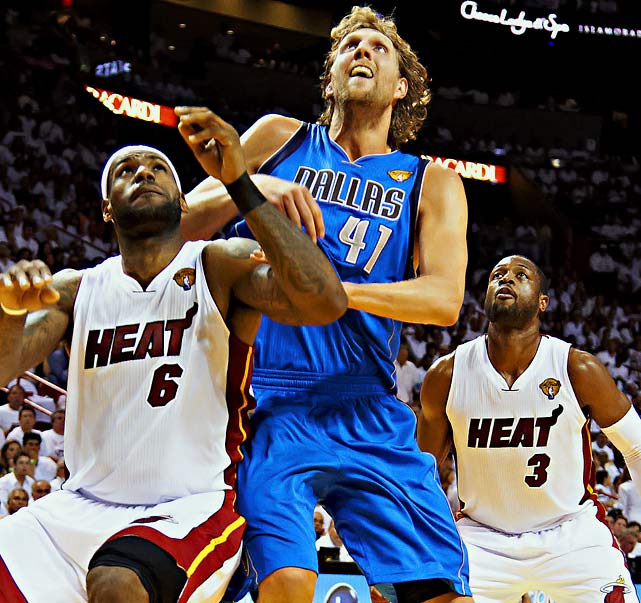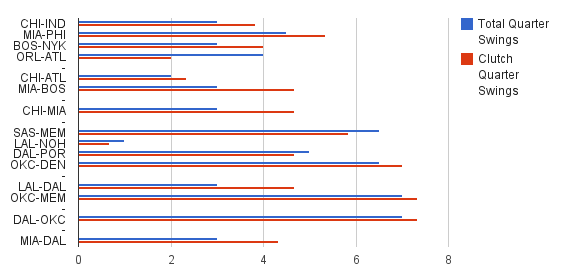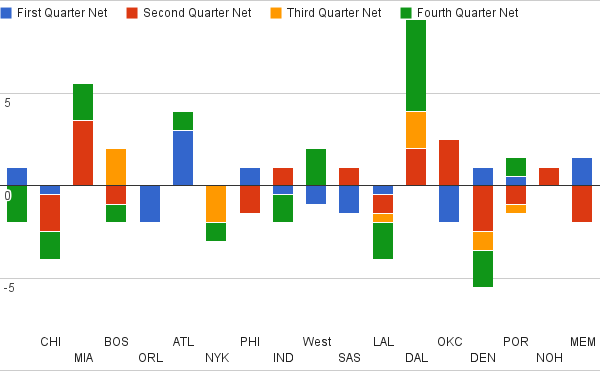Alex Learns Stats: Drawn and Quartered
Posted on Thu 15 December 2011 in The Stats They Carried by Alex Dewey

Aaron's fascinating look into the inherently deleterious effect of the compressed season on injuries (focused on effects wrought solely because more games fit into the same recuperation period) got me thinking. As stat posts are wont to do. What if it weren't the number of games that were compressed, but the games themselves? We've all heard the tired LeBron jokes. I tried to make change with LeBron, but he didn't have a fourth quarter. Well...what if nobody had a fourth quarter? How would we make change then?! What if that was the price of the lockout? What if Commissioner Stern, in a jaw-droppingly flamboyant abuse of power, declared that the cost of a lockout would be felt every night, for 12 missing minutes?
... well, I had some spare time and wanted to try my hand at these public Google Doc spreadsheet posts that Aaron has been using, guess we're going to find out. Follow me hither to the magical world of endless, tedious data entry, where Aaron and I frolic among the sparse statistical flowers of wisdom to be found there. This is kind of a curiosity, but there were a few interesting surprises.
• • •
Part I: the Data and the Damage Done
For this part, turn to Sheet "Game Data" in the spreadsheet.
Let me walk you through this sheet: As you will quickly notice, the results of each game in every 2011 playoff series (15 series, 81 games in all) are listed; Eastern Conference first, Western Conference second, Finals last. My source for this was the decent 2011 NBA Playoffs Wikipedia page. For each playoff game there are two rows: one row for each team, containing their performance in each of the four quarters and OTs if necessary. These seven columns (and then the "F" column denoting final score to the right) are straightforward. After that, NQ1, NQ2, NQ3, and NQ4 give the final score of each of the games if (respectively) one of the quarters had been unceremoniously lopped off the game (the latter naturally, by $tern, thereby protecting his most marketable player LeBron from his characteristic fourth-quarter meltdowns). The next four columns summarize which team (if any; there were 5 ties) won the game when the quarter in question got lopped off. For example, the first series listed is Bulls-Pacers. If you lop off the first quarter of Game 1 (which the Bulls actually won 104-99), the new final score is 81-72 Bulls.
Part II: Series Swing, via Django Reinhardt
For this part, turn to Sheet "Series Summary" in the spreadsheet.
"If only Stern had gotten rid of the fourth quarter like I've been saying for months, we might've beaten the Mavericks!"
--Heat, Thunder, Lakers, Celtics, Pacers, Bulls fans
This page concisely summarizes some of the data from the "Game Data" page. Here you see the 15 series from this year's playoffs, with 5 groups of columns: First the actual result (so, say, for Bulls-Pacers, the actual result was 4-1 Bulls). Then the four alternate results of the series if you remove one of the quarters from every game. If you remove the first quarter of each of the games in CHI-IND, the series is a less dramatic 3-1-1. It was a hilariously close series (not so much if you're a Bulls fan), wasn't it?
Anyway, a big takeaway is that a lot of series swung on individual quarters (full list below). If you take out the fourth quarters, the 4-1 Bulls-Pacers Series becomes 2-2-1. (You can see this in the Game Data page, but it's clearer and more concise on the "Series Summary" page). This 2-game swing was actually quite common for series: In fact, in 13 of 15 series, removing at least one of the quarters either swung or tied the series. Even the two sweeps (Celts-Knicks, Mavs-Lakers) had a quarter (3rd, 4th respectively) that, if removed from every game in the series, tied up the series at 2-2. Of course, the Thunder-Grizz series was 4-3 Thunder (as the series ended up) except for with the 2nd quarter removed, in which it's 4-3 Grizz. That sounds about right.
Strangely, the only two series that didn't hinge on any of the quarters were Bulls-Hawks and Lakers-Hornets. More on the Hornets series later (because it's a hilarious exception to everything here, as you'll see).
Here are the quarters without which various series swung victors or were tied up:
Eastern Series Swings:
- Bulls 2, Pacers 2, 1 Tie, Q4
- Heat 2, Sixers 2, 1 Tie, Q2
- Celtics 2, Knicks 2, Q3
- Magic 4, Hawks 2, Q1 (Magic take a decisive victory!)
- Heat 2, Celtics 3, Q4 (And the Celtics likely advance without the Heat's fourth quarters)
- Bulls 3, Heat 2, Q4 (And the Bulls likely advance without the Heat's fourth quarters)
- Spurs 3, Grizzles 2, 1 Tie, Q1 (An astonishing 3.5 games hinged on the first quarter [G1, G3, G5, and G6]. That's right, in 4 of 6 games the winning team won the first quarter and the losing team won the rest of regulation by a smaller margin. None of the conclusions in this piece are very strong, but this fact is strong empirical evidence that Spurs-Grizz was one of the best series of this or any playoffs.)
- Mavs 3, Blazers 3, Q2 (With only a one-game difference from the actual result, this is not too strange on its own, but note also that 3 games actually hinged on this quarter).
- Thunder 1, Nuggets 3, 1 Tie, Q2...alternately, Thunder 2, Nuggets 3, Q4 (This was the only series that hinged on the removal of two separate quarters. Not mathematically impossible, but kind of spooky, especially considering that the series was so lopsided by record and there were only 5 friggin' games (and 4 Thunder victories) for it to swing. Depending on how you look at this, the Thunder either executed when they needed to or barely won an eminently winnable series.)
- Lakers 2, Mavs 2, Q4 (this is kind of a running theme for Dallas)
- Mavs 2, Thunder 3, Q4 (see?)
- Mavs 2, Heat 4, Q4 (how does that joke go?)
Part III: the Most Exciting and Least Exciting Teams
For this part, turn to Sheet "Results by Team" in the spreadsheet.
If any of this seems "unmotivated" or "slipshod" to you, you're probably right. This is mostly a curiosity. I wanted to use the larger sample size of a regular season, but I couldn't find a database with readily available quarter data for each game. A spidering script would probably be necessary, and although Aaron is actually really good at writing those, he's busy right now and I don't have quite the experience he has. Even with the larger sample, the results simply wouldn't be very meaningful in all likelihood, at least not without lineup data and some (READ: any) degree of statistical sophistication.
That said, there's still an mathematical interpretation that motivates all of this: The number of quarters on which a game hinges approximates the probability that you're watching the decisive quarter at any given point in time in that game. If there's a game where removing the second or fourth quarters of a game can change the outcome, then if you pick a quarter at random to watch, you're 50-50 going to be watching a decisive quarter (and then at some point, very likely, a decisive run). This logic goes for series as well: Let's say you're watching the Spurs-Grizzlies series for one quarter, where 6.5 total quarters turned out to be decisive (that is, where removing the quarter changes the outcome of the game [I awarded .5 for ties]). That means if you're tuning in, there's about a 25% chance you're watching the quarter, the run, on which the whole game may swing. Granted, it might not be very exciting to watch a first quarter that the Grizzlies win by 8, even if the Spurs come back to lose by 2, but the point is, the quarter mattered directly to the outcome (and hence the narrative) of the game and of the series, and you had a relatively high chance to see it.
It's kind of silly to call any close game inherently exciting, but March Madness is so iconic for a good reason: A highly contested outcome can make decent games into great games and great games into transcendent games. And it's hard for a game in which two quarters are separately decisive to the outcome not to be incredibly close. With this slipshod and specious logic in mind, let's consider the most "exciting" series of the playoffs by the total number of decisive quarters:
I'm not going to trumpet these numbers. I do think it's telling that whenever a series seemed more interesting than these numbers establish, it's usually because the fourth quarter accounted for most of these swings (see, Mavs-Heat). Also, if you listed your most exciting 5 series from 2011 as the 3 Thunder series, Spurs-Grizz, and Mavs-Blazers, you wouldn't be too far off. There's at least some sort of strong correlation between excitement and total quarter swings. But yeah, the numbers seem just a bit off. So I made an adjustment: I did a weighted average of the first through fourth quarters, where the fourth quarter swings count (arbitrarily) 6 times as much as the first quarter swings. I also weighted the 2nd quarter swings twice as much as the first and the third quarter swings three times as much. Below is the new result:
Okay, well, that doesn't change all that much in terms of rankings, but every Heat series goes up, every Thunder series goes up (!), and every Dallas series except the Blazers went up. That sounds about right. Also, the Hornets-Lakers series goes down even further? This makes sense: It was by far the series with the fewest quarters that outcomes hinged on. In fact, there was only one quarter in the whole series that was decisive to the outcome of a game, and that decisive quarter was Q2 of Game 4. The Hornets actually hung on to win by 5 while winning the quarter by 7. Using quarter swings (with or without adjustment) just isn't a perfect measure of excitement, as the Hornets series tells us -- that series was exciting as hell.*
*An exciting series not in the "close game" way; it was more of a "Chris Paul may be tiny but he's also the most technically skilled, tenacious, creative player in the entire league and there's an outside chance he shocks the world in this series" way.
Anyway. The bottom table on this page of the spreadsheet is just a retread of the stats in "Series Summary." On the top table, we look at actual W-L records by team, and their alternate records if all of one of their quarters had been lopped off each of their games (by $tern; I can't $tre$$ thi$ enough).
Here's a summary chart:
For me, there are a few incredibly strange details here: ATL had a rather inexplicable 3 game net in the first quarters, and Chicago had a pretty surprisingly negative haul considering they went to the ECF. But really, look at Miami's: It's the one with the red/green bars above the line and nothing else. Apparently - even with the infamous Finals chokes - they overall netted 2 games in the fourth quarter (i.e. they would've lost or tied 2 more games without the 4th). And then they netted 3.5 games in the second quarter and then nothing in the first and third quarters. I guess... asking LeBron for change is actually a very strange proposition. Maybe you get two of those Kennedy half-dollar pieces or something?
Whatever coins you'd get, it's not as strange as asking Dirk. I'm kicking myself for not making the color scheme above out so that the Mavs (that gigantic pillar a bit right of center) would have a German flag in the three colors. Whatever the colors, they show us a marvel: Out of 21 games and just 16 wins, the Mavericks netted 5 games on decisive fourth quarters. I mean, many of us saw him claw back to dominance in Games 4 and 5 of the OKC series and Games 2 and 4 of the Heat, not to mention a couple Lakers games. Still, it's pretty amazing that despite that B-Roy throwback in which Dallas choked harder in the fourth than possibly any other team this playoffs... in the end tally, they still netted +5 wins in the fourth quarter. And then they netted 2 each in the second and third quarter. I think it's fair to say that Dallas was almost certainly not benefiting from sheer random chance alone in these numbers. You have to wonder what Mark Cuban's staff and crew is up to, and this is another piece of weird evidence in their favor. Also, check out Denver. Somehow, in 5 total games they managed to lose in 5.5 decisive quarters and win in 1 more. Again, mathematically this is possible. But it's spooky. That was a freaky series.
Anyway, using my definition of "excitement" from above, I created an "Objective Excitement Index" for each team. The meaning? Well, for every 100 points on a team's OEI, there's (on average) an extra decisive quarter per game on which the margin of victory hinges. For a 100 OEI team, there's a good chance that a random quarter you're watching of them is decisive to the game; for a 50 OEI team, there's only going to be (even one) decisive quarter about half the time. The highest theoretical value is 300, for a team that always wins (or loses) one quarter out of four, but manages to lose (win) the game in the other three quarters, in such a way that all three of the losing (winning) quarters are decisive. This happens, for example, if a team loses a game by 1 by losing each of the 2nd, 3rd, and 4th quarters by 7 (net: -21), even though it wins the first quarter by 20. This has to happen in every game, win or lose, for a team to have an OEI of 300. The average OEI for teams in the playoffs was about 80. In the 2011 playoffs, Denver had an OEI of 130, averaging 1.3 decisive quarters per game. This is really spooky. Possibly stranger is the Thunder having a 120 OEI in 17 games. I also did a "Clutch" version weighted as above (1,2,3,6 for each quarter). But enough talk; let's look at the chart:
Conclusions
Not too many bombshell surprises here. But definitely some nice charts. Especially unsurprising is how many games seemed to hinge on the clutch quarters (22.5 games actually hinged on the fourth quarter compared with 14, 18, and 7 for the other three). I think that's a major reason the playoffs seemed so good this season. For the most part, you never felt like a game was going to be bad going in (at least ignoring the two Hawks series), and even if your favorite team got killed by a transition masterpiece in the third quarter of Game 4, you still knew the execution in the fourth quarter was going to get better, and that your team would still have a chance next game. The end of regulation for the Spurs against the Grizzlies in Game 5 is one of the great sequences of offensive execution in the history of basketball (sorry, bias creeping in there, but really, 4 different San Antonio baskets in 40 seconds, damn!), and despite being brilliant and enigmatic, that type of execution was characteristic of the West playoffs.
It would really be nice to get a larger sample size for a real analysis of these numbers that couldn't be explained away by sheer random chance (except for Dallas and Miami, really, who both produced incredible, qualitatively clutch performances on their respective paths to the Finals before the Mavs took the decisive upper hand in Games 2 and 4), but this is mostly a curiosity anyway. A fun one, but a curiosity all the same.


